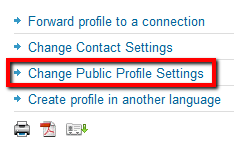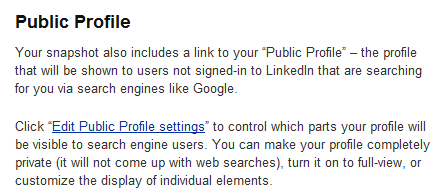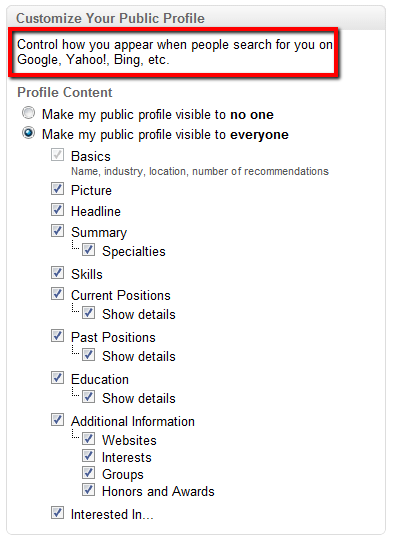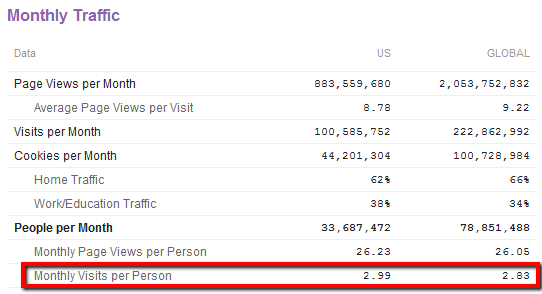If you happen to do quite a bit of LinkedIn X-Ray searching, you might be noticing that some people are taking control of how they appear in public search results.
Or maybe you aren’t noticing it, because you can’t.
Confused?
Read on to learn more.
LinkedIn Profile Changes
I’m not exactly sure when this change was introduced (anyone?), but I recently noticed that LinkedIn is taking very obvious efforts to bring the editing/control of the public profile to the attention of users.
They’re obvious to me at least. :-)
When you look over to the right side of your profile, you will notice “Change Public Profile Settings:”
When you click that, you get this huge blue call-out:
How’s that for in-your-face?
In the LinkedIn learning center, if you scroll down and take a look at the Public Profile section, you will notice some very descriptive text explaining exactly what the public profile is – “the profile that will be shown to users not signed-in to LinkedIn that are searching for you via search engines like Google.”
Similarly, in the section where you can customize your public profile, LinkedIn directly suggests you “control how you appear when people search for you on Google, Yahoo!, Bing, etc.”
Big Deal?
No, not really.
However, I personally find it interesting to watch LinkedIn’s first obvious move to educate their members on their public profile – specifically with regard to commenting directly to the technique of searching for LinkedIn profiles via the web.
Before the above changes, to the average (non-recruiter/sourcer/power) user, it wasn’t very obvious what the public profile was, let alone how making changes would affect anything, or that people actually do use Internet search engines to find LinkedIn profiles.
To the regular LinkedIn user, these new phrases (e.g., “control how you appear when people search for you on Google, Yahoo!, Bing, etc.) won’t warrant special attention. To power users, especially sourcers/recruiters – they are obvious counter-moves to effective X-Ray searching.
Which is fine – we’ve all been suspecting that LinkedIn would be making some changes. I’m personally surprised it’s taken so long.
How You Might Be Affected
What happens if someone selects “Basics” for their public profile?
That means that only their name, industry, location, number of recommendations is findable/visible in an Internet search.
Which means that if you are searching for people on LinkedIn and you are using Bing or Google to do so, you simply can’t find people who selected “Basics” with keyword/title searches because LinkedIn isn’t showing the titles and keywords in the headline, summary, specialties, skills, current position, past positions, education and additional information sections to Internet crawlers.
It also means that if you are searching inside of LinkedIn and find a profile that is not in your network, you may not be able to take a person’s headline or other text from the LinkedIn profile and search for it and actually find it with an Internet search engine – because it won’t be there. It might be cached for a short while, but after some time, Bing, Google and Yahoo! won’t have it anymore.
Lastly, if more people select “Make my public profile visible to no one,” these folks won’t be showing up in any of your X-Ray searches, even by name.
The Good News
The average LinkedIn user (not people like us) visits LinkedIn 3 times per month (that’s a quantified stat).
These people don’t really dive deep into configuring their profile (which poses a challenge to identifying/retrieving them in the first place if they don’t list any experience!!!), let alone their account and public profile settings. Of course – this may change over time, but I don’t see it as rapid or high volume.
On the other end of the spectrum, more savvy LinkedIn users (non-recruiters) may likely see the benefit of being able to show up in searches on the Internet based on more info than just the “Basics,” which is pretty much only good for finding someone with a direct name search.
It is unfortunate that more people, including active, passive and non-job seekers, don’t understand that if they want to be found by others who are beyond their network on LinkedIn that they need to be “findable” via the Internet. That means actually entering some information on their LinkedIn profile beyond titles and companies and also not limiting their public profiles to “Basic.”
On a last note – it’s nice to see that LinkedIn’s first moves in this space aren’t technical in nature (directly affecting X-Ray search results), but rather passive user-behavior education/modification.
Like many, I am waiting to see LinkedIn’s next move.





